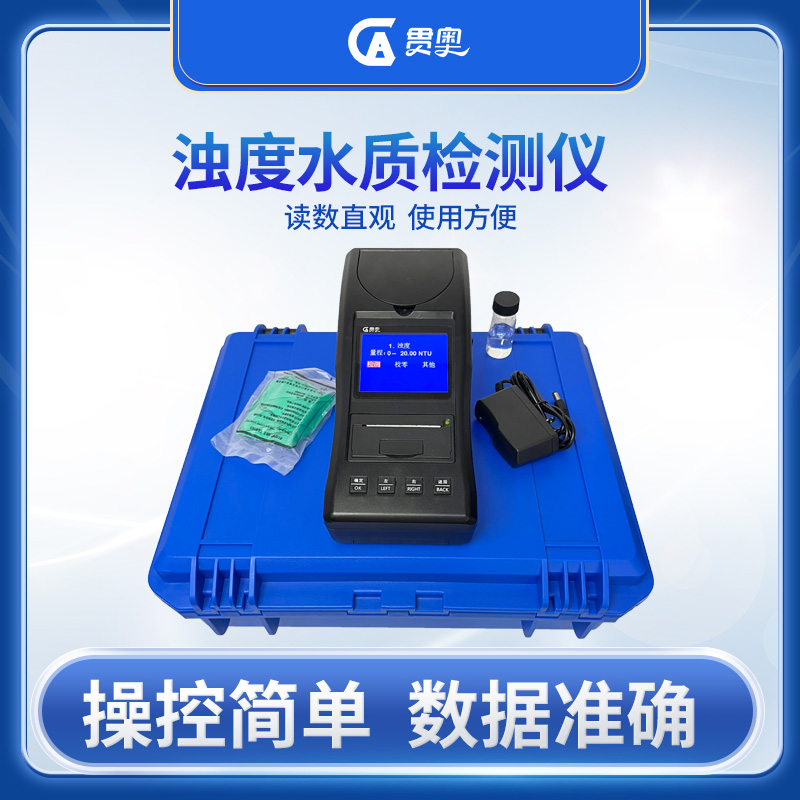The working principle and application range of turbidity detector
发布时间:2023/4/4 11:10:04 来源:贯奥仪器仪表 作者:便携式多参数水质分析仪器 阅读次数:7
Turbidity is very important in many industries, and its concentration can affect the quality and efficiency of production. Therefore, real-time monitoring and control of turbidity is necessary in daily water use. And this requires the use of turbidity analyzers. As a common water quality analysis equipment, it mainly consists of light sources, detectors (receivers), data processing units, etc. Through it, we can monitor the water quality status in real time, identify problems in a timely manner, and take measures.

The principle of turbidity detector
Turbidity detectors generally adopt the principle of scattered light, which typically uses a light source to emit a beam of light. When the light enters the water sample, it interacts with the particles in it, forming a scattering phenomenon. The direction of light propagation is deflected, and the intensity of the light also changes. The weaker the intensity of light, the more particulate matter in the water, and the higher the turbidity.
The light source of a turbidity detector is usually an LED or laser, and the emitted light is collimated by a collimating lens before shining at a certain angle on the water sample. Detectors usually use photodiodes or photoresistor to measure the received scattered light intensity and convert it into electrical signals. And these signals are transmitted to a data processing unit. During processing, it is necessary to compare the scattered light signal measured by the detector with the background light to eliminate the influence of the background light on the measurement results. At the same time, it is also necessary to calculate the turbidity value of the water sample based on the measurement results and the preset calibration curve.
Which industries are turbidity detectors used in
Turbidity detectors are widely used in water quality monitoring, environmental monitoring, drinking water treatment, sewage treatment, pharmaceuticals, food processing, and other fields.
Water quality monitoring: Turbidity is one of the important indicators for measuring water quality. Turbidity detectors can be used to monitor the turbidity of water sources such as tap water, groundwater, river water, and lake water, determine whether the water quality meets relevant standards, and ensure people's drinking water safety.
Environmental monitoring: Turbidity detectors can be used to monitor atmospheric pollution, industrial wastewater, effluent from sewage treatment plants, and other fields, providing turbidity data reference for environmental monitoring.
Drinking water treatment: Turbidity detectors can be used in the process of drinking water treatment to monitor the effectiveness of coagulation, flocculation, filtration and other processes to ensure that the water quality meets the hygiene standards for drinking water.
Wastewater treatment: Turbidity detectors can be used to monitor water quality changes during the wastewater treatment process, such as the removal effect of suspended solids and sludge settling effect, providing reference data for wastewater treatment.
Pharmaceutical: In the pharmaceutical process, turbidity detectors can be used to monitor the suspended particle content of drugs to ensure the quality of drugs.
Food processing: Turbidity detectors can be used to monitor the content of liquid suspended solids in food processing to ensure the quality and hygiene safety of food.
It should be noted that turbidity detectors are not precise measuring instruments, and their measurement results are influenced by many factors, such as the distribution of particulate matter in water, the transparency of water samples, and the stability of light sources. Therefore, when using a turbidity detector, it is necessary to calibrate the instrument and follow certain operating procedures to ensure the accuracy and reliability of the measurement results.
The above is the working principle and application industry of turbidity detectors. Different turbidity detectors have different characteristics and application ranges, and users can choose the turbidity detector that suits them according to their actual needs.
